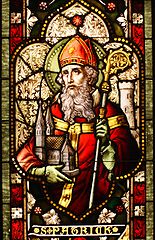
The Life And Writings Of Saint Patrick -Saint Patrick
V.—PATRICK AMONGST THE CIARRAIGE OF MAGH AI
Patrick next went from Cruachan into the place which the Tripartite calls Tir Cairedo, and Tirechan Magh Cairetha; but it is evidently the same name. It is about eight miles west of Cruachan, and lay around the modern town of Castlerea. In this plain Patrick founded a church near the place called Ard-lice, and he left therein Deacon Coeman. From him the church came to be called Kilkeevan; and the parish naturally took its title from the church. The old church was little more than a mile from Castlerea, to the west, and its ruins, or rather its site, in the old churchyard may still be seen, near the mansion of O’Conor Don, at Clonalis. Of Deacon Coeman himself, we know nothing else; but the epithet would seem to imply that he had been a deacon in the religious family of Patrick, and he is described as a youth dear to God and to Patrick. The name is Irish, and it may be that he was in some way connected with the district. The modern parish of Castlerea is, properly speaking, the parish of Kilkeevan, and, as such, is set down in all the parochial registers of the diocese of Elphin, of which it forms the most westerly district. It was also called Sen-domnach, being the oldest church of the place; but that name has disappeared from the memory of the people.
From Kilkeevan Patrick turned his steps northward, and came to Ard Senlis—the Height of the old Fort—and there he built a church, wherein he placed the holy virgin Lallocc; and near it he obtained another church site in Magh Nento. It would appear that Lallocc had her convent and oratory at some distance from the church of Magh Nento. The place is now known as Fairy Mount, a conspicuous hill about five miles north of Castlerea. Magh Nento was the surrounding plain.
Now, Patrick had in his company at Fairymount the holy Bishop Cethech, whom he first met, so far as we can judge, at Duleek, in Meath. Finding him a worthy youth, he had him trained, and then consecrated him a bishop. But though the mother of Cethech was of the Cenel Sai of Domnach Sairigi, near Duleek, his father was of the race of Ailell; so now when he found himself near his father’s people he, together with Lallocc, and the priest of Magh Nento, if not with Patrick also, resolved to pay a visit to his father’s people. But what came of it is uncertain, for it is not there but at Oran, as we shall presently see, he founded his church; and Oran certainly was not in Tirerrill. It is distinctly brought out, however, that Bishop Cethech used to visit his mother’s friends in Meath; ‘and it was his custom to celebrate the Great Easter at Domnach Sairigi, near Duleek, but the Little Easter he used to celebrate at Kells (Cennannus) with St. Comgilla,’ because, as his monks used to say, it was he that had given the veil to that holy maiden, and so he retained, at least by courtesy, the right to visit her convent. The whole story is mentioned incidentally, and, perhaps, out of place; nor indeed is it likely that St. Patrick went further northward on this occasion.
But it is stated expressly that he went a little to the south into Hy Maine. The northern boundary of this territory may be taken roughly as extending at that time from Ballymoe on the Suck to Lanesborough on the Shannon, so that when Patrick came into the barony of Ballymoe he was in the Hy Maine territory. There he founded a church about three miles west of Roscommon town at a place called Fidarta, or as it is now called, Fuerty, on the left bank of the Suck, although the parish includes both banks of the river at this place. Therein he left an archdeacon, or rather a chief deacon, of his household, namely, Deacon Just or Justus, whom, of course, he ordained as priest. To him also he gave ‘his own book of ordinal and of baptism,’ that is his missal and ritual, and Justus baptised the Hy Maine, and amongst them, we may add, was the celebrated St. Ciarain, the founder of Clonmacnoise. But this was long after, in his old age, as the Tripartite expressly states. It was about the year A.D. 512 when, according to the Tripartite, Justus was 140 years old, ‘as the best authorities say.’ But the numerals in these cases given in the manuscripts are always uncertain. The ruins of an ancient church still remain at Fuerty; but it certainly was not a building of the time of St. Patrick.
In the parish of Athleague, south of Fuerty, there is a stone called Gloonpatrick (Glun-Phadruig), so called because ‘it bears the mark of Patrick’s knee, which he left there when praying.’ It shows that Patrick must have gone further south into Hy Many, either on this occasion or more likely later on when he was returning from the West to Tara, and went through Magh Finn on his way to Athlone.

 Keep Site Running
Keep Site Running